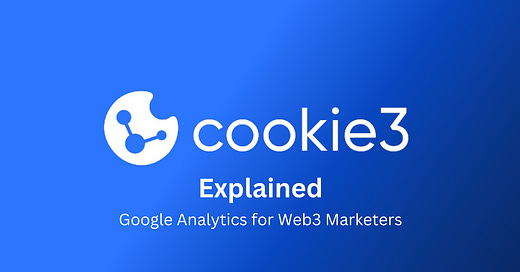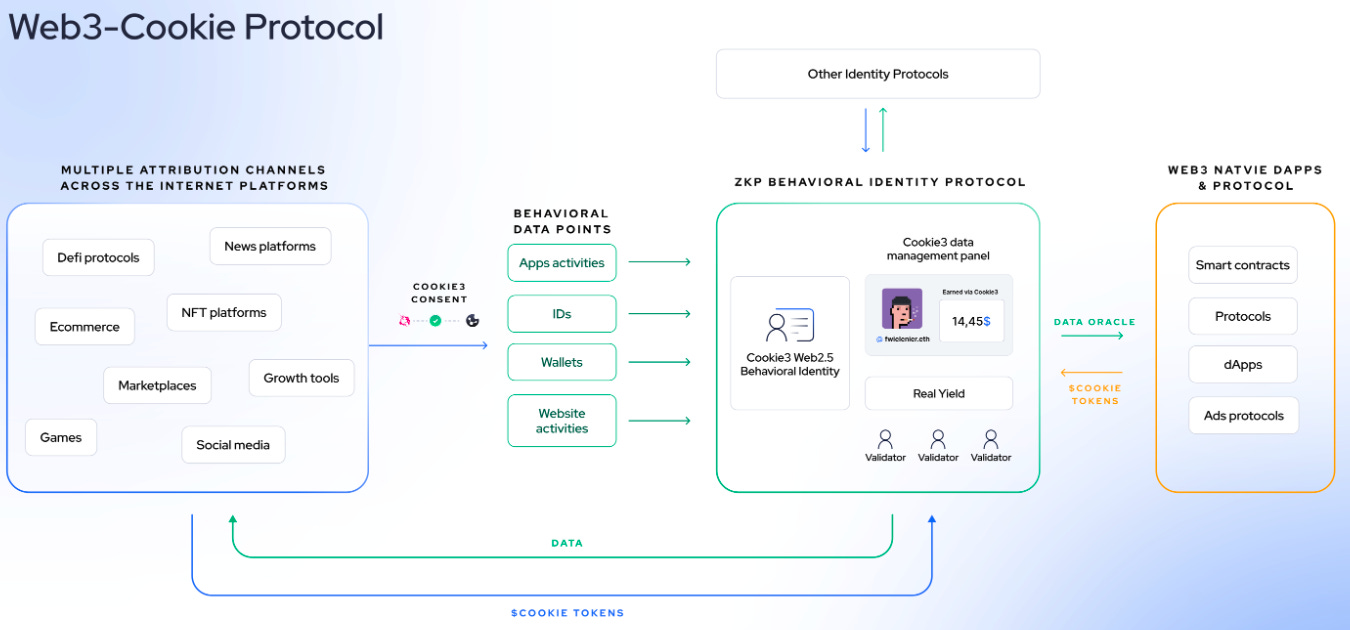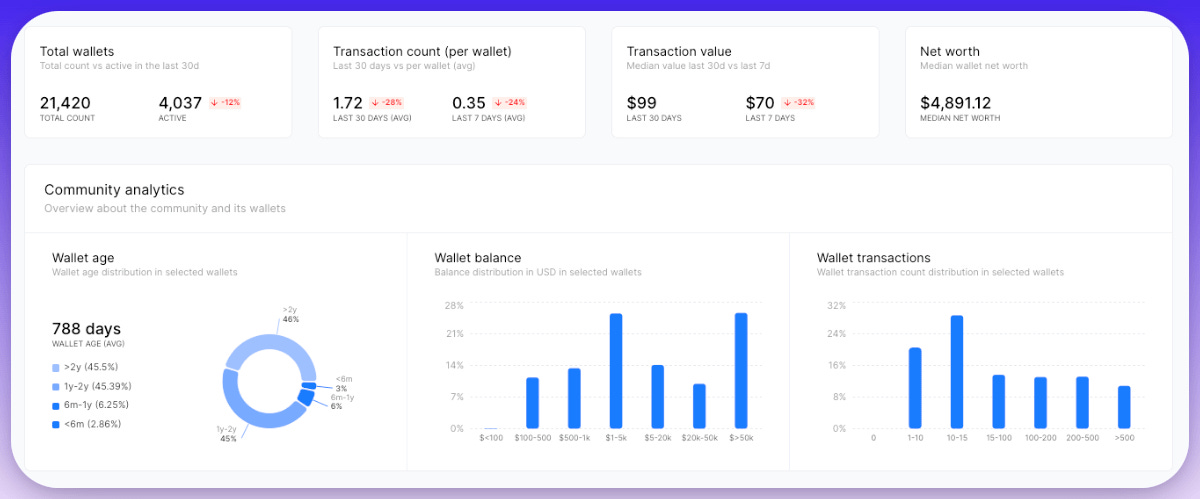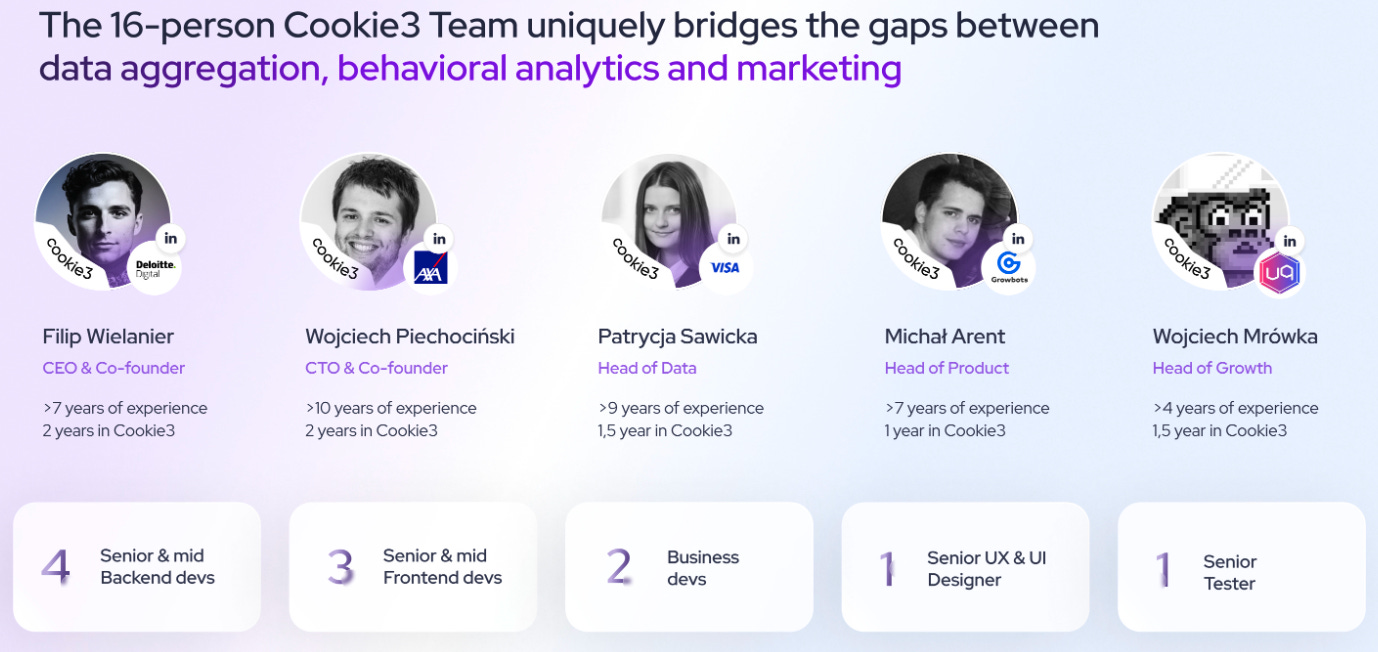Cookie3 Explained: Google Analytics for Web3 Marketers
Exploring how analytics works in web3 marketing and how Cookie3 works
Disclaimer: The content presented in this article, along with others, is based on opinions developed by the analysts at Dewhales and does not constitute sponsored content. At Dewhales, we firmly adhere to a transparency-first philosophy, making our wallets openly available to the public through our website or DeBank, and our articles serve as vehicles for self-expression, education, and contribution to the ecosystem.
Dewhales Capital does not provide investment advisory services to the public. Any information should not be taken as investment, accounting, tax or legal advice or as a recommendation to purchase, sell or hold or to pursue any investment style or strategy. The accuracy and appropriateness of the information is not guaranteed by Dewhales Capital.
Introduction
1. Transitioning Foundational Approach
2. Web3 Marketing Roles
3. Introducing Cookie3 - Google Analytics for Web3 Marketers
4. Web3 Cookie Protocol
5. An Application Case Study
6. Core Team Members
7. Cookie3 Backers
Conclusion
Introduction
Online digital marketing in the Web2 space is something that we all live with everyday, with content poured into our view as we interact with apps and websites, learning our behaviour in the background as our data gets mined for targeted recommendations. However, digital marketing has also lost its effect comparative to the earlier days for a multitude of reasons. High levels of competition, blindness in recommendations, dependencies on the large tech media platforms due to data silos and closed ecosystems are a few reasons that customer conversion and merchant penetration only get harder.
Web3 founders also face a similar challenge in order to reach the masses. It is a double-edged sword to be marketing a protocol or a dapp via Web2 social platforms, as they provide the intended audience in terms of adoption, but the medium to deliver promoted ads are treated as shills and scams by most people who have been in crypto for some time. Moreover, there is a dilemma on customer targeting as Web3 natives treat interaction and engagement very seriously. In essence, it is much more user-centric and focused on 2-way feedback and communication.
1. Transitioning Foundational Approach
A direct comparison of Web2 and Web3 marketing can be viewed from 2 perspectives, namely the business desire and the user interaction needs.

Common strategies that Web2 advertising employs include creating eye-catching content, capturing attention through mass digital media, and building brand awareness via influencers. All the while, content targeting is optimised with backend algorithms using a user's interaction data. However, it is often perceived as a one-way engagement, where users are limited to receiving information only. This is partly due to traditional businesses typically treating marketing and customer support as two separate functions, thereby breaking the interaction chain between the two.
Web3 marketing, on the other hand, emerged out of necessity, targeting a specific user group in a non-mass market. While Web2 users typically stick to a handful of everyday apps, Web3 users are accustomed to interacting with more than 20 protocols simultaneously, especially heavy DeFi users who diversify their on-chain wealth to pursue the best yields or gain early access to potential airdrops. As a result, achieving user retention becomes an immensely challenging metric in an environment characterised by significant liquidity fragmentation. Moreover, many Web3 entities lack large marketing budgets (except for those that are well-funded) and cannot afford to casually expend funds to attract users. This approach is particularly ineffective as Web3 farmers are known for their mercenary capital mindset, departing once incentives are exhausted.
Hence, protocol founders resort to a more intimate approach, building rapport with their users through constant interaction while depending on word-of-mouth for "brand" awareness to spread. This fostering of relationships is key to Web3 marketing, as loyalty is driven by shared ownership (e.g., NFTs, governance tokens), culture (e.g., maximalism), and incentivizing user contributions (e.g., potential airdrops, micro-rewards).
2. Web3 Marketing Roles
Having discussed how Web3 marketing has to adopt a more personal approach to build rapport with its users, it naturally creates a role gap that has now evolved into legitimate job positions. This transition indicates that protocols take engagement seriously and are willing to invest in people to grow their "brand" while working to onboard new users through popular campaign management platforms such as Zealy, Galxe, and Tide.
As nicely summarised in a blog post from Talent Protocol, we provide a high-level overview of marketing roles that form the backbone of many of our favourite dapps.
Product Marketing Manager
Responsibilities: Develop go-to-market strategies aligned with product and feature releases, conduct market research, handle messaging to users, create marketing collateral and content, run product launch campaigns
Community Manager
Responsibilities: Building community brand culture, manage and moderate users and stakeholders, creating social media content, facilitate communication and major announcements between the protocol teams and users, expand interaction channels to encourage feedback gathering, event management
Content Marketing Manager
Responsibilities: Create and execute content marketing strategies, manage content writers and designers, create content covering protocol features and studies (e.g. whitepapers, articles, blogs), manage data metrics and analytics of content engagement and conversion rates, manage content calendars and subject themes
Social Media Manager
Responsibilities: Create and execute social media strategies, managing social media accounts, ensure brand messaging and communication consistency, manage data metrics and analytics of engagements, spotting social media trends and applicability
Influencer Marketing Manager
Responsibilities: Identifying relevant influencers and their audience, negotiating partnerships and collaborations, create and execute influencer marketing campaigns, develop strategies and approaches to increase influencer engagement
These job roles come with respective challenges as well, considering that Web3 protocol development moves at the speed of light. Moreover, the repercussions on users are real especially when dealing with the anonymous nature of protocol founders, hacks and scams where money is lost, and where reputation can go down the drain in an instant. While marketing roles in Web2 can mostly be seen as a background job, Web3 marketing jobs are very much in the frontlines because they are a voice of the brand.
How then can marketing tooling keep up with the growth of marketing jobs in Web3, and how can these new professionals continue to drive credible outreach while growing user-initiated engagement?
3. Introducing Cookie3 - Google Analytics for Web3 Marketers
Cookie3 is an analytics-focused platform that aims to enable a holistic view on user activity online across both the Web2 and Web3 space. The team behind has split the development of their product into 2 major phases:
Web3 Privacy “Google Analytics”
Web3 Cookie Protocol
Web3 Privacy “Google Analytics”
One of the first steps that needs to be addressed to support the onboarding of Web2 marketers intending to join the Web3 markets is to create a similar tooling experience to match their existing expertise. Consequently, the ability to discover data metrics and bridge actions on-chain to user interactions via a dapp website would also be required.
Hence, the main pain points that the platform aims to address are:
Web3 projects do not know their customers’ journey, attribution and conversion rates
Marketers handle Web2 and Web3 data separately, losing a holistic view of user behaviour and their journeys
Current behavioural analytics tools do not care about user data ownership and self-sovereign identity
Therefore, a platform that targets the aggregation of on-chain activity, interaction points and popular social media was created into a product solution encompassing:
Analytics dashboards
Analyse data by token transactions, user demographics, social media engagement, NFT sales, wallet activity etc.
Examine user behaviour patterns to identify trends in preference
Track user segments and demographics to tailor marketing approach
Enhance targeting and personalisation
CRM (Customer Relationship Management) Organise on-chain (EVM) and off-chain customer data
Establish user segments based on token holdings, demographics, social media engagement etc.
Conduct in-depth analysis of user behaviour patterns
Campaign Manager
Optimise marketing campaigns
Track marketing ROI
Manage custom UTM links for better understanding on user acquisition channels
API Integration Platform
Streamline data management of on-chain and off-chain data sources
Structure data to preferred formats
4. Web3 Cookie Protocol
The second part of Cookie3 involves bridging the need for 2-way feedback from user interactions and micro-rewards to encourage users to interact further for the generation of data profiles. By enabling users to monetize their data into micro-rewards while still maintaining authority over who they share their information with, combined with the ability for Web3 marketers to target users via on-chain transactions, sums up the intention of Cookie3 and its business model.
The protocol aims to leverage on cookie consents to introduce self-sovereign identity (SSI) consent for Web 2.5, enabling better data ownership and customisable data sharing.
Value propositions for businesses adopting this model are:
Gives users full ownership of their digital behavioural data
Provide opt-in/opt-out options aligned with Web3 principles
Reward users with your own token or COOKIE3 tokens for better engagement
Optimise marketing spending across Web2 and Web3
Value propositions for individuals include:
Have full ownership of your internet data and identities
Optionality for data sharing
Pre-select type of data to be released to businesses
Earn based on your data shared
Leverage zero-knowledge proofs to release the information you want to
For such a tool, a critical aspect for development is to support different chains and protocols to reach the widest possible audience and customer base. This is why Cookie3 currently supports Ethereum, BSC, Polygon, Avalanche and even newer chains such as Mantle and Linea, with more than 150 web3 projects already using the tool:
5. An Application Case Study
The use case is based on Notum and its interaction with Cookie3, as their marketing manager prepared go-to-market campaigns, influencer onboarding, quests, and so on. However, he had to define measurable metrics such as customer acquisition cost, channel responses that yielded the best results, customer base definition, and so on. The obvious route was to begin with Web2 tools such as Google Analytics, but the marketing manager quickly realised that there was a gap, as he could not link on-chain holdings, transaction channels, and wallet interfaces with the tool.
The first order of business on Cookie3 was to upload a spreadsheet containing some basic information about blockchain wallets, such as wallet balances, transaction counts, portfolio sizes, transaction frequency, and token holdings. Instantly, Cookie3 produced a basic analytics dashboard mapping out the data within the spreadsheet. In a single view, the information from the spreadsheet provided multiple angles for further investigation.
The next step was to assess the success of using quest platforms as a channel for onboarding. Despite the acclaimed success of Web3 campaign management platforms, data collected from these campaigns and presented on Cookie3 immediately showed that the average user balance was much less than what Notum was targeting. Consequently, he decided to stop using quest campaigns as a channel, saving the protocol from spending funds on a likely irrelevant channel to source users.
Moving on from their campaign launch, it was time for the marketing manager to determine which methods were the most effective in acquiring the relevant audience. Using Cookie3, he generated multiple UTM (Urchin Tracking Module) links to track each sub-campaign and gather data. The evaluation focused on channels among influencers, ad protocols, and DeBank broadcasting. Data gathered from all three channels were once again uploaded into Cookie3, showing which channels were worth investing in more, while others needed to be cut out entirely.
All in all, the marketing manager managed to leverage data-driven insights almost immediately on Cookie3, allocating budgets to optimise the most efficient channels. Moreover, data reporting was made simple, structured, and streamlined.
This case study has showcased the first part of Cookie3 and intends to demonstrate how Web2 methodologies can be extended to Web3 analytics with the correct tooling. With this as a baseline, the second component of Cookie3 can evolve to become an even better targeting tool to weed out airdrop farmers and help protocols convert campaigns into real users at a higher rate.
6. Core Team Members
Filip Wielanier (CEO and Co-Founder): Former Deloitte Digital professional, Filip, combines a strong 7+ year background in marketing, IT, and banking with proven leadership skills. He's adept at managing teams from start to finish in international projects and has been an influential figure in the crypto sphere for 5+ years. An active community member since 2018, Filip leverages his technical know-how and entrepreneurial spirit to solve complex problems, drive business development, and improve user experiences. His leadership and strategic thinking have been instrumental in leading projects to successful completion.
Wojciech Piechocinski (CTO and Co-Founder): With 10 years of hands-on experience in the IT industry, he specialises in development, software and solution architecture design, and DevOps. His career has led him to tackle challenges with processing massive amounts of sensitive data, particularly during his time with renowned insurance companies like AXA. As a Tech Lead, Wojciech has built whole solutions end-to-end, contributing not only his technical skills but also his leadership in guiding projects to successful completion. Wojciech’s comprehensive background showcases a commitment to innovation, efficiency, and the ability to deliver complex, data-driven solutions tailored to meet the needs of large-scale enterprises.
Patrycja Sawicka (Head of Data): Data scientist with over 9 years of experience in developing AI solutions. Her expertise lies in understanding business problems and aligning innovative software engineering products to solve them. In Visa she led several projects: segmentation, lifestyle indicators behavioural analysis and behavioural sustainability score. She submitted multiple innovation submissions for IP protection and she has already been rewarded with several technical innovation awards and one patent application. Before Visa, she worked as an AI engineer on computer vision and IoT solutions. Patrycja has extensive knowledge of software development, python programming language, AI and business analysis
Michael Arent (Head of Product): Michael is an experienced software engineer with a knack for end-to-end product design, from concept to launch. He has dabbled in web, web3, and marketing tech, turning ideas into user-friendly designs. He is also proud to have led a team that launched a web app which drew over 1.4 million users. Michael is passionate about web apps and blending tech with business to create standout products.
Wojciech Mrowka (Head of Growth): Web3 evangelist with an engineering background, Wojciech boasts a successful track record in the industry since 2020. Previously, he was the NFT Marketing Lead at Uniqly.io and advisor for projects within the Polish crypto scene, including AdShares and others. With a remarkable passion for cryptocurrencies and blockchain technology, Wojciech has been actively engaged in producing insightful content in this domain for over 5 years and is also a lecturer for SGH postgraduates in the field of "Blockchain: business, law, technology".
7. Cookie3 Backers
Backers of Cookie3 include companies such as: Dewhales, Spartan Group, Big Brain Holdings, Hartmann Capital, LD Capital, Jsquare, Master Ventures, Orange DAO, Block 54, Gravity Team, Grizzly Capital, Blockchain Ventures Hub, Stakez Capital, Synapse Ventures, Wealth Union, Pointer Capital, Danxia Capital, Crypto3 Capital, Metavision and others.
Conclusion
Web3 marketing as an industry vertical is here to stay, as protocols aim to expand their reach not only to crypto-native users but also seek ways to onboard more users and broaden their customer base. The vertical is still in its infancy, where actors are figuring out how to optimise their marketing material while ensuring they have the correct branding representation to the public.
The purpose of marketing tools built for Web3 is not necessarily about how in-depth or customizable the software is, but how easy it is for both blockchain and Web2 marketing professionals to acquire, present, and investigate data in the easiest and most seamless ways.
Cookie3 has provided the first half of the solution, allowing marketers to better and more easily understand their on-chain user base while presenting information in a simple way for their management to digest. Coupled with the goal of solidifying their position in Web3 data management and intent on the future of user self-custodied data with the application of micro-rewards, the interaction model between users, protocols, and data analytics tools will continue to evolve. We are witnessing the next generation of MarTech growing in the Web3 industry, and the convergence of transparent data on the blockchain is becoming leveraged and interpreted in ways non-Web3 natives can understand and appreciate.









